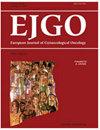The effect of other high-risk HPV types on cervical intraepithelial neoplasia and cancer
IF 0.5
4区 医学
Q4 OBSTETRICS & GYNECOLOGY
引用次数: 1
Abstract
Objective: Cervical cancer is an serious healthcare problem with a high mortality rate. High-risk Human papillomavirus (HPV) genotypes, especially HPV 16, 31, 33, and 18, are the leading cause of cervical cancer and cervical intraepithelial neoplasia. Cervical cancer screening programs, especially ones that are HPV-based, have gained prominence in many countries. Herein, we evaluated the effect of other high-risk (hr) HPV types (HPV 31, 33, 35, 39, 45, 51, 52, 56, 58, 59, 66, and 68) with normal cytology on cervical intraepithelial neoplasia and cancer. Methods: 9015 patients were screened via HPV typing and cytology. 520 patients with high-risk HPV positivity, aged 25–65, and unvaccinated for HPV were included in the study. Patients with high-risk HPV DNA positivity and cytologic abnormality, HPV 16–18 positivity, or with high-risk HPV DNA positivity and normal cytology or with postcoital bleeding and/or suspicious appearance of the cervix underwent colposcopy and colposcopic-directed biopsy. Results: Of the 520 women included in the study, the prevalence of the hr-HPV types is as follows: HPV 16 (29%), HPV 18 (13.7%), other high-risk HPV (43.8%), and HPV 16 or 18 plus other hr-HPV (13.5%). Among patients diagnosed with ≥ CIN2, 36.3% had HPV 16 positivity, 21.8% had HPV 18, 24.2% had other hr-HPV and 17.7% had co-infection with HPV type 16 and 18 and other hr-HPV types. HPV 16 (Odds Ratio (OR) = 3.099, 95% Confidence Interval (CI) = 1.933–4.968), HPV 18 (OR = 4.834, 95% CI = 2.715–8.608), and co-infection with HPV 16 or 18 with other hr-HPV types (OR = 3.324, 95% CI = 1.851–5.969) were statistically significantly associated ≥ CIN2 on biopsy. Among patietns with normal cytology and positive for other hr-HPV types CIN2+ was detected in 10.3% of patients who underwent biopsy, but only 1.5% had CIN3 and no cancers were detected. Conclusion: Consistent with our national screening guidelines, the risk for CIN3+ for women with normal cytology but positive for hr-HPV types other than 16 and 18 is low. Re-testing these patients in one year appears acceptable.其他高危型HPV对宫颈上皮内瘤变和癌症的影响
目的:癌症是一个严重的医疗保健问题,死亡率高。高危型人乳头瘤病毒(HPV)基因型,尤其是HPV 16、31、33和18,是导致宫颈癌症和宫颈上皮内瘤变的主要原因。癌症宫颈癌筛查项目,尤其是基于HPV的筛查项目,在许多国家都得到了重视。在此,我们评估了细胞学正常的其他高危(hr)HPV类型(HPV 31、33、35、39、45、51、52、56、58、59、66和68)对宫颈上皮内瘤变和癌症的影响。方法:对9015例患者进行HPV分型和细胞学检查。520名年龄在25-65岁且未接种HPV疫苗的高危HPV阳性患者被纳入研究。高危HPV DNA阳性和细胞学异常、HPV 16-18阳性、高危HPV DNA阴性和细胞学正常、性交后出血和/或宫颈可疑外观的患者接受了阴道镜检查和阴道镜导向活检。结果:在纳入研究的520名女性中,hr型HPV的患病率如下:HPV 16(29%)、HPV 18(13.7%)、其他高危型HPV(43.8%)、HPV 16或18加其他hr型HPV(13.5%)。HPV 16(比值比(OR)=3.099,95%置信区间(CI)=1.933–4.968)、HPV 18(OR=4.834,95%CI=2.715–8.608)和HPV 16或18与其他hr HPV类型的共同感染(OR=3.324,95%CI=1.851–5.969)在活检中与≥CIN2具有统计学显著相关性。在细胞学正常且其他hr-HHPV类型阳性的患者中,10.3%的活检患者检测到CIN2+,但只有1.5%的患者患有CIN3,未检测到癌症。结论:与我们的国家筛查指南一致,细胞学正常但除16型和18型以外的hr型HPV阳性的女性发生CIN3+的风险较低。在一年内对这些患者进行再次检测似乎是可以接受的。
本文章由计算机程序翻译,如有差异,请以英文原文为准。
求助全文
约1分钟内获得全文
求助全文
来源期刊
自引率
25.00%
发文量
58
审稿时长
1 months
期刊介绍:
EJGO is dedicated to publishing editorial articles in the Distinguished Expert Series and original research papers, case reports, letters to the Editor, book reviews, and newsletters. The Journal was founded in 1980 the second gynaecologic oncology hyperspecialization Journal in the world. Its aim is the diffusion of scientific, clinical and practical progress, and knowledge in female neoplastic diseases in an interdisciplinary approach among gynaecologists, oncologists, radiotherapists, surgeons, chemotherapists, pathologists, epidemiologists, and so on.

 求助内容:
求助内容: 应助结果提醒方式:
应助结果提醒方式:


